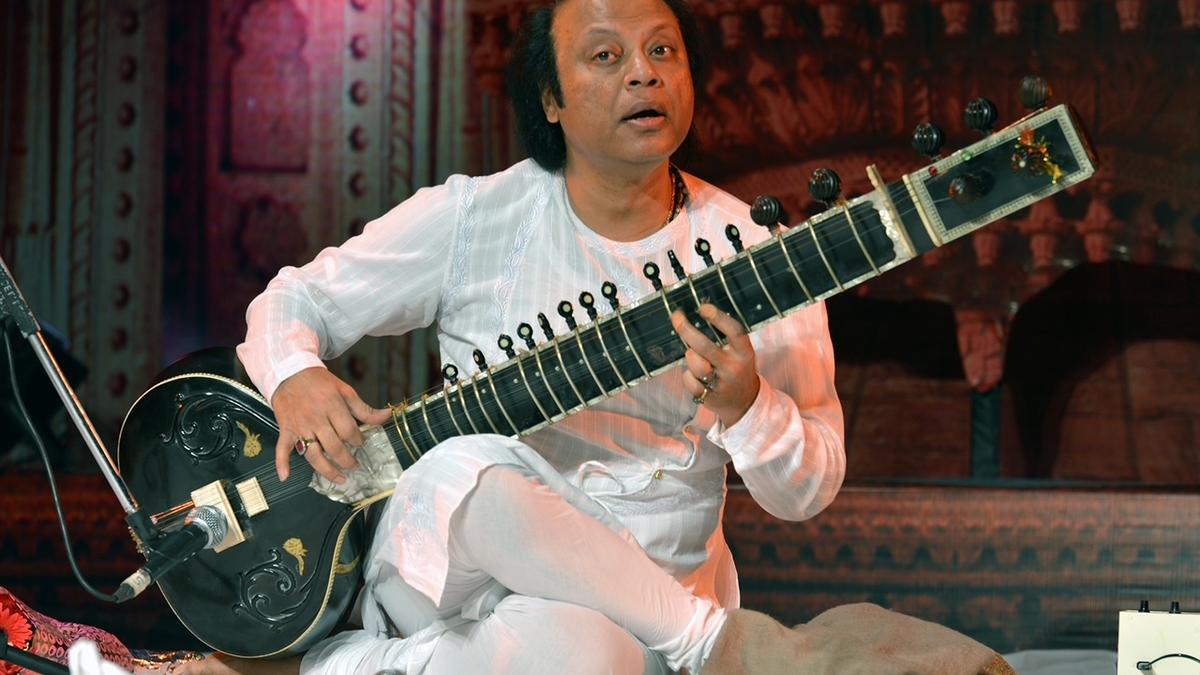
How Ustad Nishat Khan’s concert turned into a masterclass in classical music
The Hindu
In a rare outing, Ustad Nishat Khan once again impresses audience with his artistry
Ustad Nishat Khan is choosy about where he performs, and so his concerts are eagerly awaited. His recent Strings of Melody show in Delhi — he played there after seven years — organised by HCL Concerts drew a full house.
Nishat is the eldest son of Ustad Imrat Khan, younger brother of Ustad Vilayat Khan, and the torchbearer of a six-generation legacy. He left school to continue sitar practise, and began performing concerts when in his mid-teens. Incidentally, he recorded his first All India Radio (AIR) concert at the age of 15.
Nishat’s music is satisfying as it has a nostalgic, familiar feel. Though highly creative, he builds on tradition, extensively using different sitar ‘baaj’ to present a full picture of his artistry. Thus, in a Nishat Khan concert there will not be only meends, fast taans, laykari and a usual jhala, but also bolkari, gamaks, krintan and full fledged jor. He does not just present one or two dimensions of the raag, as is the norm these days. He rarely plays new compositions or new taals; understanding that unless it enhances the music, there is no need for overtly expressed novelty.
At Strings of Melody, Nishat played raag Aiman or Yaman, for an hour. He would have played this over 300 times in concerts and many many more times in ‘riyaaz’, but his Aiman still sounded fresh. Of course, the secret is in feeling the notes, not just rendering them mechanically. Occasionally using the shudha madhyam delicately, but without turning the raag into Aiman Kalyan, Nishat showed his mastery. After aalap and a wonderful sequential jor, he played an expansive eight-bol jhala. The lau he created was magnificent — one understood it is not only clarity of stroke or speed that makes for a satisfying jhala.
Nishat then moved onto the compositions, of course, in Teen taal, the most used taal of his gharana. Unusually, he was accompanied by two tabla players — both young representatives of old traditions. Shariq Mustapha hails from Ustad Ahmed Jan Thirakwa’s house and Zuheb Ahmed is the grandson of Ustad Hashmat Ali Khan of the Ajrada gharana.
The madhya laya gat was Nishat’s composition, with an unusual pick up of the mukhra from the 14th beat. Proceeding in an unhurried manner as is his style, Nishat created an enjoyable ambience. The two tabla players interspersed his sitar with subtle and short crisp solo pieces. Wisely not finishing the first piece with an ultra fast jhala, Nishat gracefully moved onto raag Bahar. Choosing this raag as it is a raag of the season, Nishat also displayed his taalim and mastery of raags as he also played flashes of jor raags of Bahar – Hameer Bahar and Basant Bahar. In the manner introduced by his uncle Ustad Vilayat Khan, Nishat also sang the lyrics of the iconic ‘Sakal ban phool rahi sarson’. Nishat then moved onto raag Shahana, in which he played a racy ‘drut’ gat popularised by his uncle. Keeping the audience hooked with his double speed taans, Nishat ended in an exhilarating jhala. He concluded the two-hour concert with a Chaiti in Mishra Pahari. As he explained, in Chaitra maas, Chaitis are a must.
Nishat’s concert reminded one why the current trend of compressing music into an hour-long format, with two raags being quickly showcased, is not the best way to enjoy classical music. Of course, one needs the vastness of Nishat Khan’s musicality to engage the audience for an hour with just one raag.





















 Run 3 Space | Play Space Running Game
Run 3 Space | Play Space Running Game Traffic Jam 3D | Online Racing Game
Traffic Jam 3D | Online Racing Game Duck Hunt | Play Old Classic Game
Duck Hunt | Play Old Classic Game











